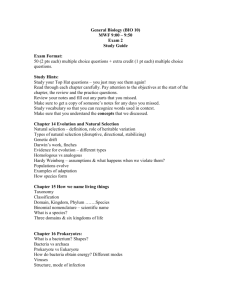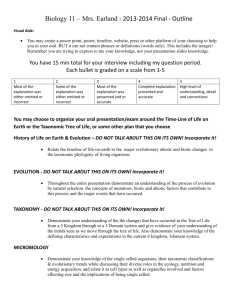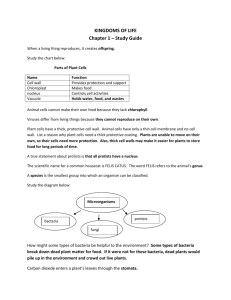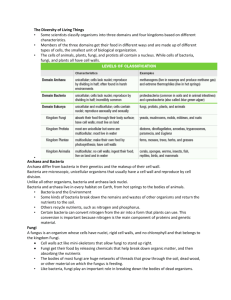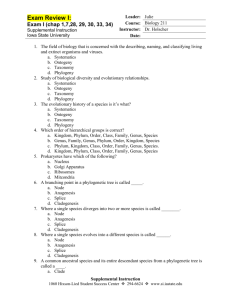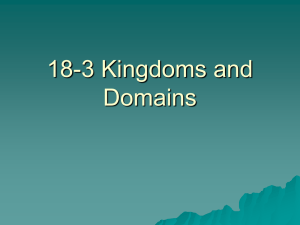unit three – life on earth
advertisement
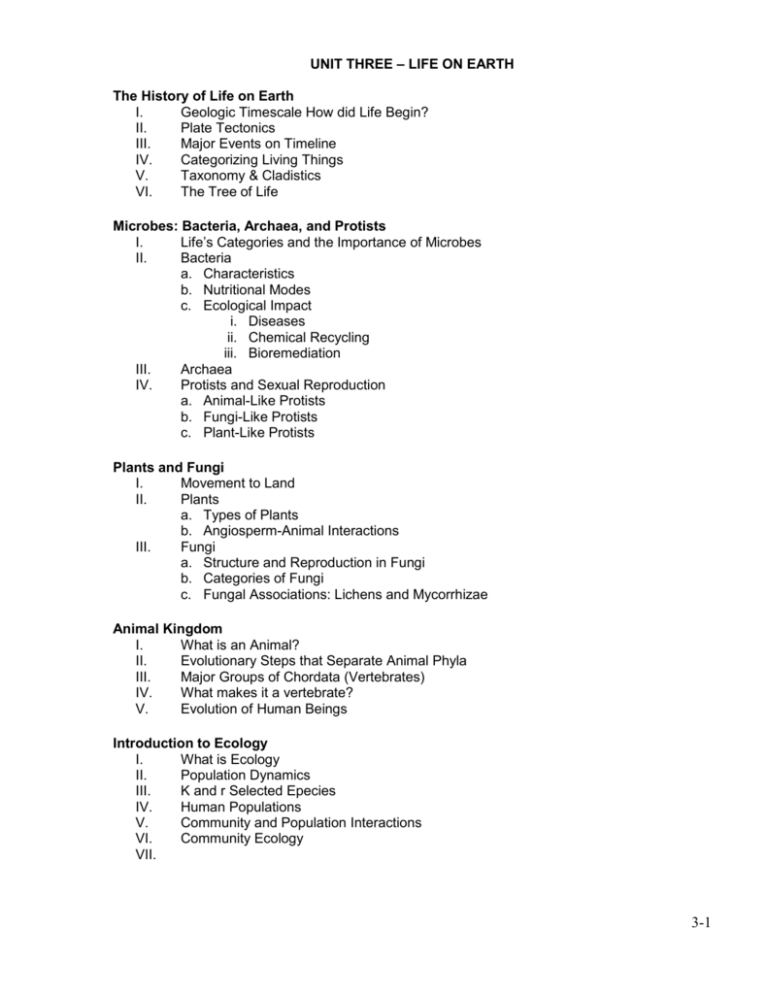
UNIT THREE – LIFE ON EARTH The History of Life on Earth I. Geologic Timescale How did Life Begin? II. Plate Tectonics III. Major Events on Timeline IV. Categorizing Living Things V. Taxonomy & Cladistics VI. The Tree of Life Microbes: Bacteria, Archaea, and Protists I. Life’s Categories and the Importance of Microbes II. Bacteria a. Characteristics b. Nutritional Modes c. Ecological Impact i. Diseases ii. Chemical Recycling iii. Bioremediation III. Archaea IV. Protists and Sexual Reproduction a. Animal-Like Protists b. Fungi-Like Protists c. Plant-Like Protists Plants and Fungi I. Movement to Land II. Plants a. Types of Plants b. Angiosperm-Animal Interactions III. Fungi a. Structure and Reproduction in Fungi b. Categories of Fungi c. Fungal Associations: Lichens and Mycorrhizae Animal Kingdom I. What is an Animal? II. Evolutionary Steps that Separate Animal Phyla III. Major Groups of Chordata (Vertebrates) IV. What makes it a vertebrate? V. Evolution of Human Beings Introduction to Ecology I. What is Ecology II. Population Dynamics III. K and r Selected Epecies IV. Human Populations V. Community and Population Interactions VI. Community Ecology VII. 3-1 Intro to Anatomy and Physiology I. Basic Characteristics of Humans II. Review of Organization III. 4 Types of Tissue IV. Summary of Systems 3-2 The History of Life I) Geological Time a) Life’s timeline starts about 4.6 billion years ago b) Divides time into eras, then periods, then epochs i) Fossil define a layer (large period of time) c) Major extinction events seem to mark the layer division i) Usually marks the end of an era or period (1) Pleistocene (2) Cretaceous (3) Permian d) Cambrian Explosion II) Plate Tectonics & Macroevolution a) History of Plate Tectonics i) III) Major Events in Geologic Time a) Earth formed 4.6 bya by meteors b) 3.5 bya – first prokaryotic cell c) 2.7 bya – Oxygen accumulation d) 2.2 bya – first eukaryotic cell e) Cambrian Explosion IV) Categorization of Living Things a) Carolus Linneaus (Carl von Linne) i) Swedish scientist that started naming everything in Latin ii) Is a way that we can talk to people in other countries and all use the same name b) Binomial Nomenclature i) Genus (genera) species – always italicized c) Degree of Relatedness i) Members of the same species are more related than members of the same Genus ii) Systematics iii) Taxonomic System 3-3 V) Taxonomy and Cladistics a) Phylogeny b) Variations in Morphology that make it hard to label i) Homologous Structures ii) Analogous Structures iii) Convergent Evolution c) Classical Taxonomy i) Concerned with special qualities of an organisms, not descent d) Cladistics (means branching in Greek) i) Brings about a Cladogram ii) Ancestral Characters iii) Derived Characters VI) The Tree of Life a) Universal ancestor b) Three Domains i) Bacteria ii) Archea iii) Eukarya _____________________________________________________________________________ Study Questions: Geologic Time/Evolutionary Overview Most of the Eras and periods we use to define geologic times were determined by what? What is the role in plate tectonics in evolution? Which is the period when all the present phyla are first present in the fossil record? The Earth is approximately how old? When do we see high accumulation of oxygen on the Earth probably happened 3-4 Bacteria, Archaea, and Protists I. Prokaryotes a. Bacteria i. Characteristics of bacteria: b. Archaea II. Modes of Nutrition A. Autotrophs a. Photoautotrophy (plants, some bacteria and many protists) b. Chemoautotroph (some bacteria & archea) B. Heterotrophy—obtain energy from organic material a. Photoheterotrophy (Some bacteria & archea) b. Chemoheterotrophy (animals, all fungi, most bacteria, many protists, & a few plants) III. Ecological Impact of Bacteria A. Mutualism: B. Resident bacteria that line our linings a. 100 trillion bacteria in digestive tract – most in large intestine i. 600 species of bacteria in mouth alone ii. Number of individual bacteria in mouth may exceed number of people ever existed b. Without bacteria, may require 30% more calories to maintain weight i. Have a lower number of intestinal cells that move nutrients ii. Metabolize sugars we cannot digest and produce some vitamins iii. One-quarter of feces by weight consists of bacteria 3-5 C. Bacteria and Human Disease a. Pathogenic b. Damage comes from substances secreted or left behind (toxins) i. Toxins - IV. D. ii. Bacillus anthracis – secretes 3 toxins causes blood vessels in lungs & brain to hemorrhage iii. Botulism bacterium – toxins stop signals from moving from nerves to muscles (paralysis) c. Antibiotics – kill bacteria Chemical Recycling E. Bioremediation Protists a. Origin of Eukaryotes Animal-Like Protists A. (Formerly protozoa), do not obtain nutrients from photosynthesis, instead from consumption and internal digestion. a. Paramecium – B. Ameboid protists – use pseudopods to take in foods by Endocytosis a. Ameboid protists i. Giardia lamblia 3-6 Fungi-Like Protists A. Two Step Food Gathering Process of Fungi B. Fungus-like protists, oomycetes, operate the same way C. Examples: a. Irish Potato Famine, Phytophthora infestans killed off all the potato farms b. Water mold (saprobes) c. Plasmodial slime mold: several forms during its life-cycle. d. Dictyostelium discoideum, “cellular slime mold” A. Plant-Like Protists (algae) “Golden” alga, freshwater Synura scenedesmus B. Volvox, green algae C. Brown alga D. Phytoplankton – (golden and Volvox) 3-7 Study Questions for Microbes Bacteria can be what shapes? How are bacteria used in human bodies, recycling nutrients, etc. What is bioremediation? What are Archaea? Where do you find them? What are the possible origins of organelles in the eukaryotic cells What are the feeding types for protists? What are they related too? 3-8 Plants: The Foundation for Much of Life Terrestrial Movement from Water to Land How do you go from Algae to Plants? Alternation of Generations Types of Plants A. Mosses: bryophytes easy to overlook, but common in wet terrain B. Ferns: seedless vascular plants appear next in fossil record C. Seed plants developed two main evolutionary designs—pollen and seed. 3-9 The Flowering Plants: Nature’s Grand Win-Win Invention A. Appeared in Cretaceous and soon replaced gymnosperms as dominant vegetation flourishing by 80 Mya. B. Efficient pollination made for runaway reproductive success. C. Seeds containing endosperm are unique to angiosperms. D. Fruit production is other important reason for angiosperm success (along with flower formation). Allows co-opting of animals a second time. Plant Diversity: What Else do we use Plants for? 3-10 Kingdom Fungi A. Fungi are absorptive heterotrophs a. Thought to be like plants i. Sessile, have cell wall (chemically different from plants) b. Now known to be quite different. 77,000 species identified so far B. Characteristics Structure and Reproduction in Fungi A. Hyphae have porous cross-walls (septae), allowing rapid growth & quick exchange of materials. a. Gills on a mushroom are collection of hyphae with a reproductive structure called a basidium at their tip b. Tens of millions of spores i. Spore – B. Reproduction: a. Almost always multicellular—with both haploid and diploid phase in life cycle b. Dikaryotic cells as part of sexual reproduction 3-11 Diversity of Fungi A. Grouping of Fungi is mainly based on reproduction Ecological Impact A. Decomposers B. Parasites C. Commercial Uses Fungal Associations: Lichens and Mycorrhizae A. Ecologically important symbiotic relationships. a. Lichens b. Mycorrhiza _____________________________________________________________________________ Study Questions for Fungus and Plants After the fusion of two mushroom hyphae, what is the ploidy level? What are some food that come from fungi What do we call the slender filaments that connect their internal area of fungus? In mass? A symbiotic association between a algae and a fungus is referred to as a what? Which animal moved onto land first? What about plants? These plants still hugged the ground and were dependant on water for reproduction Gymnosperms were able to spread to more land environments because they developed what? Angiosperms are now the dominant plant type on the planet, mainly due to animal attraction. Which of the following is not a way Angiosperms attract animals 3-12 Animal Kingdom What is an Animal? A. Characteristics B. Big steps in Geologic Time a. Cambrian Explosion Evolutionary Steps that Separate Animal Phyla A. Phyla are defined by body plan shared common ancestor a. Common ancestor probably protist called choanoflagellate, then split to yield Porifera (sponges); lack tissues and symmetry. b. All the rest have some kind of symmetry c. Body cavities in which organs are suspended called coelom d. Protostomes, meaning “mouth first,” and Deuterostomes, “mouth second” differ in what blastopore develops into during embryonic development 3-13 B. Major Steps that lead to divisions a. Phyla Porifera – Sponges b. Phyla -Cnidarians - jellyfish i. Two Stages of LIfe c. Phyla Platyhleminthes – flatworms d. Phyla Nematoda - roundworms, parasitic, trichinosis, hookworm e. Phyla Annelida - earthworms 3-14 f. Phyla Arthropoda 3 groups g. Phyla Mollusca - Probably 50,000–100,000 species, 8 totally different classes h. Phyla Echinodermata i. Phyla Chordata 3-15 Vertebrate Groups A. Phyla a. Cephalochordata b. Urochordata c. Vertebrata B. Evolution a. Development of jaws: b. Cartilage to bone c. Transition to land-dwelling vertebrate d. Amniotic egg: e. Major Evolutionary of Land Vertebrate i. Reptiles ii. Mammals 3-16 1. Characteristics a. Mammary Glands b. Endothermic c. Viviparous i. Oviparous ii. Ovoviparous 2. 3 Lines Evolutionary Lines of Mammals – embryonic development a. Monotremes b. Marsupials c. Placental Mammals C. Evolution of Primates a. What makes a primate? b. Emergence of Humankind i. Misconceptions: 3-17 ii. All are hominids but of different genera 1. Ardipithecus 2. Parathropus 3. AustralopithecusA. afarensis - “lucy” a. A. garhi may have used to tools to kill something and eat it 4. Homo a. H. habilis – used tools but isn’t that different from A. b. H. ergaster – tall, larger brain, modern face and limb length 5. How did we get everywhere? iii. Hominids had to travel around 1. Found H. erectus in both China and Indonesia 2. Two views a. One that says H. sapien was the end result of all others b. H. sapien out-competed the others i. Actually lived with H. neanderthal for 10,000 years c. How do we know whose related to whom? i. Skeletal structure can tell us more about how they moved around, DNA Study Questions for Animal Kingdom Phyla in the Animal Kingdom are characterized by their what? What are they phyla (example)? What are the characteristics of animals? What is a coelom? Why do mammals have fur? What other organism has mechanisms to keep warm? What are the reproductive options in mammals? What are those names specifically? All of our ancestors originated from which continent? Which species left Africa first? Where did H. sapiens originate? 3-18 Population and Communities in Ecology I. Study of Ecology A. Ecology a. Study of interactions that living things have with each other and their environment B. Ecologists Organism life from population to Biosphere a. Populations i. b. Community i. c. Ecosystem i. d. Biosphere i. II. Populations Dynamics A. How and why its size changes over time B. Estimating Populations a. Necessary for understanding ranges of animals, dependence on water, etc b. Trees are easy, just count ‘em. Animals are more of a challenge Estimate C. Growth and Decline a. Arithmetical increase i. b. Exponential increase i. c. Shape of Growth Curves i. Exponential Growth 1. J-Shaped growth ii. Logistic Growth 1. S- Shape growth form 2. Grows exponentially, then evens out at Carry Capacity (K) a. iii. Environmental resistance 1. Forces of nature that limit population size d. Calculating Exponential Growth i. Growth Rate 1. 2. r – a. Zero population growth r = 0 3-19 III. K-selected and r-Selected Species A. K-Selected or Equilibrium B. r-Selected or Opportunistic C. Most are a combination, more of a range (turtles are long-lived with no parental care) a. Die at anytime, constant lost IV. Human Populations A. Survivorship Curves from Life Tables a. Life tables i. Separate species’ life span into suitable units of time ii. Notes survivorship for each unit of time 1. How likely are you to live to be 10, 20, 30, etc 2. Developed by life insurance agencies B. Population Pyramid a. Separates life span into groups of years, then counts how many people fit group C. Immigration and Emigration a. Immigration – b. Emigration – D. Increase in World Population a. Exponential growth after the industrial revolution b. United States r = 0.4%; Parts of Africa r = 3% unequal growth c. 2 billion in 1927; 4 billion in1974; 6 billion now E. Impact on the environment a. We may have a smaller growth rate, but we utilize more resources b. May not be human numbers, but utilization that impacts the environment c. China less CO2 overall, way less CO2 per capita d. Americanization of the planet is not such a good thing for nature IV. Communities: Interaction of Populations A. Ecological Community a. Diversity b. Vegetation c. Stability B. Ecological Dominants C. Keystone Species 3-20 IV. Communities and Ecosystems A. Interspecific Interactions in Communities a. Interspecific Competition i. Resource Partitioning b. Habitats and Niches i. Habitat ii. Niches B. Predation a. Predator b. Prey c. Defenses d. Coloration C. Symbiotic Relationships a. Parasitism b. Mutualism D. Disturbances of Communities a. Succession i. Primary ii. Secondary E. Ecosystem Dynamics a. Trophic Levels i. Food chains ii. Food Webs 3-21 F. Chemical Cycling in Ecosystems a. Biogeochemical Cycles b. examples G. Biomes a. How climate affects biomes i. Terrestrial ii. Freshwater iii. Marine b. Coevolution H. Human Impact on the Environment a. Impact on Communities & Ecosystems b. Biodiversity c. Conservation Biology _____________________________________________________________________________ Study Questions for Ecology and Population Dynamics What is Ecology? What does Ecology study? How do we study population dynamics? What are survivorship tables? What is the carrying c capacity? What does r and K mean for population growth? What is the fundamental unit of ecology? What defines each level? What is habitat versus niche? What is the difference between abiotic and biotic? What is a food web? What are trophic levels? What is chemical cycling? Give some examples 3-22 Intro to Anatomy and Physiology I. Science of Studying Animals a. Zoology – study of animals b. Anatomy – study of internal and external structure c. Physiology – study of how those structures work (function) II. Three Basic Characteristics of Humans A. Internal Body Cavity – Coelom a. Two Main Cavities i. Dorsal Cavity 1. Spinal and Cranial ii. Ventral Cavity 1. Thoracic “chest” – lungs and heart 2. Abdominopelvic – stomach, liver, pancreas, intestines B. Internal Skeleton a. Vertebrae protect the spinal cord b. Skull protects brain by forming the cranial cavity C. Internal Temperature Regulation a. Endothermic – stable internal temperature III. Review of Organization A. Organ Systems – groups of interrelated organs and tissues that serve a particular set of functions in the body IV. 4 Types of Tissue A. Epithelial a. Lines the areas exposed to air to protect from outside world i. Keratin protein in skin is “waterproof” ii. Ex: skin, nose, lining of GI tract b. Forms Glands i. Organs or groups of cells that secrete one or more substances ii. Two Types 1. Exocrine a. Secrete material through tubes or “ducts” onto the epithelial surface (ex: sweat) 2. Endocrine a. Secrete from cell directly into the tissue b. Hormones – substances that when released in 1 part of an organism prompt physiological activity elsewhere c. Types of Epithelial Tissue i. Squamous - flat ii. Cubodial - square iii. Columnar - rectangular iv. Stratified Squamous – 2+ layers d. Attached to basement membrane i. Dense network of protein fibers & filaments that attach to deeper tissues B. Connective (not exposed to air) a. Two Jobs i. Supports and protects other tissues ii. Secretes extracellular material directly from cells b. Classified by surrounding extracellular material i. Loose connective tissue 3-23 1. Fluid like ground substance and fibers of protein (collagen) to provide strength and flexibility 2. Adipose Tissue (fat) a. Type of LC that contains fat cells b. Provides cushioning, insulation and energy stores ii. Fibrous and Supporting Connective Tissue 1. More collagen, less ground substance tougher and stronger 2. Forms: a. Tendons that attach skeletal muscle to bones b. Ligaments that connect bone to another bone c. Capsules that surround organs and enclose joint cavities 3. Supporting Connective Tissue a. Most rigid form, less fluid, more fiber b. Cartilage (in nose, ear) – support and flexibility i. Found between bones of spine, at end of limb bones as shock absorber ii. No blood vessels c. Bones i. Ground substance contains mineral deposits (calcium) calcified ii. Make bones strong and resistant to shattering iii. Fluid Connective Tissue 1. Blood a. Population of cells and plasma (ground substance) 2. Lymph a. Comes from Interstitial Fluid (fluid pushed out of capillaries into space around tissues) b. Recheck, then brought back to blood C. Muscle a. Specialized tissue – can shorten and contract b. Interaction of 2 contractile proteins (fibrils: actin and myosin) c. Striated Muscle i. Actin and myosin are regularly arranged 1. Skeletal Muscle - can have many nuclei, mainly for movement, associated w/bones 2. Cardiac Muscle - can also have 2 nuclei d. Nonstriated Muscle i. Lack regular arrangement 1. Smooth Muscle – mainly contractions, lungs, GI tract, etc. D. Nervous a. Specialized for rapid conduction of electrical impulses b. Two type i. Neurons – functional unit of nervous tissue ii. Neuroglia – provide support, nourishment and insulation, defend neurons from infection c. Structure of Neuron i. Cell body – with nuclei ii. Axon – long extension that transmits information iii. Dendrites – information transmitted to another neuron iv. Synapse – site where neuron connects with another cell 3-24 V. Summary of Systems - 11 systems in the body 3 groupings 1. Body Support and Movement a. Integumentary System – skin, glands, hair and nails i. Protects body from external environment & assists in temperature regulation b. Skeletal System – Internal supporting framework i. Bones, cartilage, connective tissue, ligaments ii. 206 bones along with lots of cartilage iii. Bones store minerals, protect soft organs iv. Some store lipids, produce red blood cells and other blood elements c. Muscular System - Movement i. All skeletal muscle (700 –voluntary) not cardiac or smooth muscle ii. Posture, balance, support soft tissue, help maintain body temperature 2. Coordination, Regulation and Defense a. Nervous System –brain, spinal cord, sense organs (ears, eyes), nerves i. Nervous tissue b. Endocrine System - hormones i. Travel through the blood stream and often function to maintain stability in the body, water conservation, temperature regulation, metabolism c. Lymphatic System i. Collect interstitial fluid and return it to the blood stream ii. Includes lymphoid organs 1. Produce or support specialized immune cells 2. Lymph nodes, tonsils, spleen, thymus, peyer’s patches 3. Transport and Exchange with the Environment a. Cardiovascular System – heart, blood, blood vessels, bone marrow (RBC production site) i. Transports nutrients, dissolved gases, hormones to tissues throughout the body ii. Carries wastes to kidneys from filtration b. Respiratory System – lungs, air passageways i. Nasal cavities, pharynx, larynx, trachea ii. Transport of Oxygen to lungs c. Digestive System – GI tract i. Mouth, esophagus, stomach, Intestines, etc. ii. Salivary glands, digestive enzymes iii. Break down food into usable particles to turn into energy d. Urinary System – kidneys, ureters, bladder, urethra i. Elimination of waste products from blood via urine e. Reproductive System i. For offspring production _______________________________________________________________________________ Study Questions for Basic Anatomy/Physiology What do we call “a group of closely associated cells that are adapted to carry out specific functions” What are the types of epithelial tissue? How can you tell? What are the types of connective tissue? What are some examples Which type of muscle tissue lacks striations and is involuntary? What is the cell type that forms nerve tissue? 3-25



